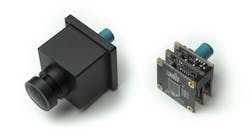OmniVision Technologies Inc. announced at the AutoSens conference its 1.3-MP OX01F10 SoC. The company claims the OX01F10 provides automotive designers with the industry’s best imaging performance across a wide range of lighting conditions, along with the most compact form factor and lowest power consumption.
In a single, 1/4-inch optical format package, the OX01F10 integrates a 3-µm image sensor and an advanced image signal processor (ISP). This solves the automotive rear-view camera (RVC) and surround-view system (SVS) challenges of achieving a small form factor with strong low-light performance, ultra-low power, and reduced cost while improving reliability by using only one printed circuit board (PCB), says OmniVision.
“Analysts predict that SVS and RVC will continue to hold the majority share in the automotive camera market, with over 50% of the total market volume through 2023. SVS, in particular, is expected to double its growth between now and 2023 because of increased customer adoption,” said Andy Hanvey, director of automotive marketing at OmniVision. “Our OX01F10 SoC provides the best option for automotive designers responding to this growing consumer demand for better RVCs, along with the expansion of SVS into the mainstream market. This SoC’s functional safety features allow module providers to create a single platform for both the viewing cameras and the machine vision applications that require ASIL B.”
OmniVision says its dual-conversion-gain (DCG) technology is employed in the SoC to achieve a high dynamic range of 120 dB with only two captures, as opposed to three required by the competition. This minimizes motion artifacts while reducing power consumption and boosting low-light performance. Its integrated ISP further enables superior image quality with a number of advanced features, such as:
- Lens chromatic aberration correction
- Advanced noise reduction and local tone mapping
- Optimizations for the on-chip image sensor’s PureCel Plus technology
PureCel Plus technology is known for its low-light sensitivity, offering an SNR1 of 0.19 lux. This results in the OX01F10 performing better than the competition across challenging lighting conditions, making it possible to eliminate unnatural halos from LEDs and provide better contrast on bright days, claims OmniVision.
The OX01F10 features less than 300-MW typical power consumption and significantly reduces temperature. It doesn't require a metal heat sink, allowing for the use of plastic camera module bodies to reduce costs. With its compact package size, it also enables smaller cameras that can fit in much tighter spaces. By integrating both the image sensor and the ISP into a single chip, designers can save on both cost and space by eliminating the second PCB in typical two-chip implementations.
The SoC provides an array size of 1340 x 1020 at 30 frames/s, which offers ample resolution for calibration. It also enables output flexibility with both 2-lane MIPI and 10-bit DVP interfaces.
The OX01F10 SoC is AEC-Q100 Grade 2 certified; samples are available now. For more information, visit here.

